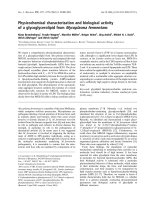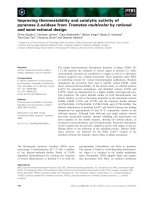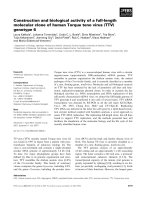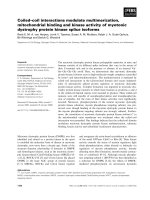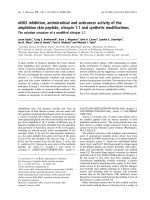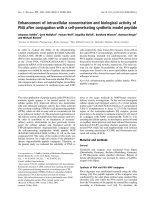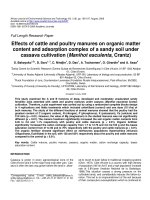Agronomic characteristics, anthocyanin content, and antioxidant activity of anthocynins extracted from the seeds of black rice accessions
Bạn đang xem bản rút gọn của tài liệu. Xem và tải ngay bản đầy đủ của tài liệu tại đây (438.78 KB, 12 trang )
Vietnam Journal
of Agricultural
Sciences
ISSN 2588-1299
VJAS 2018; 1(3): 208-219
/>
Agronomic Characteristics, Anthocyanin
Content, and Antioxidant Activity of
Anthocynins Extracted from the Seeds of
Black Rice Accessions
Phan Thi Thuy1, Nguyen Quoc Trung2 and Do Thi Huong1
1
Faculty of Agronomy, Vietnam National University of Agriculture, Hanoi 131000,
Vietnam
2
Faculty of Biotechnology, Vietnam National University of Agriculture, Hanoi 131000,
Vietnam
Abstract
The objectives of this study were to investigate the morphological
characteristics, grain yield, and anthocyanin content of 36 black rice
accessions that were collected from different locations in Vietnam.
The results showed that the black rice accessions varied in growth
duration (130 to 150 days), plant height (91.5 to 143.6 cm),
morphological characteristics, and yield components. Grain yield of
the black rice accessions ranged from 2.8 to 8.7 tons ha-1. The black
rice accessions were classified into four groups based on their
anthocyanin content: group I > 0.1% anthocyanin, group II 0.05%0.1%, group III 0.001%-0.05%, and group IV < 0.001%. BR7 had
the highest anthocyanin content (0.1438%), followed by BR5
(0.1317%). Anthocyanins with the strongest antioxidant activities
were extracted from BR8, BR35, BR6, BR27, BR30, BR32, BR18,
BR17, BR19, and BR1 with IC50 values less than 2 µg mL-1. Seven
promising black rice accessions, namely BR1, BR14, BR17, BR25,
BR30, BR34, and BR35, were selected for further research based on
their high anthocyanin contents, and good grain yield and yield
components.
Keywords
Anthocyanin content, antioxidant activity, black rice accessions,
yield
Introduction
Received: March 28, 2018
Accepted: August 27, 2018
Correspondence to
Do Thi Huong
/>
Rice (Oryza sativa L.) is the most important staple food in the
world, feeding more than 50% of the world’s population (Huang et
al., 2016), and provides up to 76% of the calorific intake of the
population in South East Asia (Fitzgerald et al., 2009). The
traditional diet in Vietnam as well as in other Asian countries is
largely based on polished white rice with a high glycemic index (GI)
or glycemic load (GL). The higher dietary GI or GL has been shown
208
Phan Thi Thuy et al. (2018)
to have a significant relationship with diabetes
and cardiovascular diseases such as lower levels
of HDL-cholesterol, higher triacylglycerol
levels, and higher HbA1c levels (Chiu and
Taylor, 2011). Nowadays, type 2 diabetes and
cardiovascular diseases are major causes of
morbidity and mortality around the world,
threatening the economies of all nations (Leeder
et al., 2004). Therefore, to curb the escalating
diabetes epidemic and cardiovascular disease,
primary prevention through the promotion of a
healthy diet and lifestyle should be a global
public policy priority (Frank, 2011).
Black rice is a good source of fibre,
minerals, and phytochemicals besides containing
basic nutrients. Recently, more and more nonglutinous black rice varieties have been
developed and gained increasing popularity as a
staple food to replace white rice (Zhang et al.,
2010). The color of black rice is caused by
anthocyanins which are the group of reddish
purple water-soluble flavonoids located in the
pericarp, seed coat, and aleurone layer
(Kushwaha, 2016). Four different anthocyanins
(cyanidin-3-glucoside,
peonidin-3-glucoside,
cyanidin-3,5-diglucoside,
and
cyanidin-3rutinoside) have been identified in black rice
(Hou et al., 2013). Anthocyanin is one of the
most important antioxidants in preventing cancer
and cardiovascular disease (Sancho and Pastore,
2012). Several research articles have shown the
positive effects of black rice on human health as
an important source of vitamins and minerals
(Meng et al., 2005), natural food colorant (Guisti
and Wrolstad, 2003; Konczak et al., 2004), antiinflammatory agent (Min et al., 2010), and
health-promoting food ingredient in combating
diabetic complications (Yawadio et al., 2007).
As consumers’ health awareness increases
and their food patterns change, research and the
development of special foods such as black rice,
colored corn, and soybeans have received much
attention (Zhang et al., 2010). However, the
phytochemicals in whole grains, including
anthocyanins, have not received as much
attention as those in fruits and vegetables
because many previous
studies
have
underestimated grain phytochemicals (Liu,
2007). Several studies have focused mainly on
/>
phytochemical content and antioxidant activity
of whole grain white rice or rice bran, and a
limited number of studies have reported the
antioxidant activity of black rice (Zhang et al.,
2010). The concentration of anthocyanins as
well as antioxidant activity is different
depending on the grain type, variety, and growth
conditions (Mpofu et al., 2006; Liu, 2007).
However, previous studies did not emphasize
different types and varieties of black rice.
Therefore, more complete analyses of
anthocyanin content and antioxidant activity of
diverse varieties of black rice are needed.
Knowing the antioxidant activity of different
black rice genotypes will give insights to their
potential application in promoting health (Zhang
et al., 2010). This current study aimed to
investigate the anthocyanin content as well as
agronomic characteristics and grain yield of
several local black rice accessions in Vietnam.
Materials and Methods
Materials
Thirty-six local black rice accessions which
were coded from BR1 to BR36 were collected
from different locations in Vietnam (Table 1).
Methods
Experimental design
The experiment was conducted in the spring
2017 season in Gia Lam, Hanoi. Rice seedlings
were transplanted into the field when they had
2-3 leaves. Hill spacing was 25 cm by 15 cm
with 1 seedling per hill. Fertilization (N-P-K)
was applied with the ratio 90-90-90 kg ha-1. The
chemical fertilizers were urea (46% N),
superphosphate (16% P2O5), and potassium
chloride (60% K2O).
Measurements and data analysis
The following growth and yield parameters
were measured following the methods of IRRI
(2013): growth duration, plant height,
morphological characteristics, yield, and yield
components. To measure the parameters, 5
plants were randomly sampled from each
cultivar, excluding plants in the two rows on
each side to avoid border effects.
209
Agronomic characteristics, anthocyanin content, and antioxidant activity of anthocynins from the seeds of black rice accessions
Total anthocyanin content (TAC) was
quantified using the pH differential method
reported by Sutharut and Sudarat (2012). TAC
was determined from the whole grain rice after
dehulling. Samples of 100 μL of grain extract
were brought up to 1 mL volume either with
0.025 M potassium chloride buffer (pH = 1.0) or
0.4 M sodium acetate buffer solution (pH =
4.5). The absorbance of each mixture was
measured at 510 and 700 nm using a UV-VIS
Table 1. List of the 36 black rice accessions
210
Code
Type
Source/province collection
BR1
Sticky rice
Cam Thuy - Thanh Hoa
BR2
Sticky rice
Ba Thuoc - Thanh Hoa
BR3
Sticky rice
Sapa - Lao Cai
BR4
Sticky rice
Ngoc Lac - Thanh Hoa
BR5
Sticky rice
Van Chan - Yen Bai
BR6
Sticky rice
Nho Quan - Ninh Binh
BR7
Sticky rice
Bach Thong - Bac Can
BR8
Sticky rice
Ham Yen - Tuyen Quang
BR9
Sticky rice
Na Hang - Tuyen Quang
BR10
Sticky rice
Da Bac - Hoa Binh
BR11
Sticky rice
Ngoc Lac - Thanh Haa
BR12
Ordinary rice
Ba Thuoc - Thanh Hoa
BR13
Sticky rice
Mai Chau - Hoa Binh
BR14
Sticky rice
Plant Resources Center, Vietnam
BR15
Sticky rice
Luc Nam - Bac Giang
BR16
Sticky rice
Nhu Xuan - Thanh Hoa
BR17
Ordinary rice
Field Crops Research Institute (FCRI)
BR18
Sticky rice
FCRI
BR19
Ordinary rice
FCRI
BR20
Sticky rice
FCRI
BR21
Sticky rice
FCRI
BR22
Sticky rice
FCRI
BR23
Sticky rice
FCRI
BR24
Sticky rice
FCRI
BR25
Sticky rice
Vietnam National University of Agriculture
BR26
Sticky rice
Crops Research and Development Institute (CRDI)
BR27
Sticky rice
CRDI
BR28
Sticky rice
CRDI
BR29
Sticky rice
CRDI
BR30
Sticky rice
CRDI
BR31
Sticky rice
CRDI
BR32
Unknown
CRDI
BR33
Unknown
CRDI
BR34
Sticky rice
CRDI
BR35
Unknown
CRDI
BR36
Unknown
CRDI
Vietnam Journal of Agricultural Sciences
Phan Thi Thuy et al. (2018)
spectrophotometer and total absorbance was
calculated using the following equation:
A = ((A510 mm–A700 nm)pH=1.0)–((A510 nm–A700
(1)
nm) pH=4.5)
where A510 nm and A700 nm are the absorbances
measured at 510 and 700 nm, respectively. TAC
(in mg L-1) was calculated using the following
equation:
TAC (mg L-1)=(A·M·DF·1000).(ε·1)-1 (2)
where A is the absorbance from Eq.1, M is the
molecular mass of cyanidin-3-O-glucoside (M =
449.2), DF is the dilution factor (100 μL of
sample was diluted to 1 mL, DF = 10), and ε is
the molar absorption coefficient of cyanidin-3-Oglucoside (ε = 26 900 L (mol·cm)-1). TAC (in %)
was calculated using the following equation:
TAC (%) = (a.100).(m.(100–w).10-2) (3)
where a is TAC in mg L-1 from Eq.2, m is the
weight of the initial material (g), and w is the
moisture content of the initial material (%).
Antioxidant capacity was performed using the
DPPH (2,2-diphenyl-1-picrylhydrazyl) Free
Radical Scavenging Method reported by Yue and
Xu (2008). The DPPH reagent (0.025 g) was
dissolved in 1000 mL of methanol for preparing
the DPPH reagent solution. Two milliliters of the
DPPH solution was mixed with 50, 100, and 150
µL of the sample solutions and transferred to a
spectrophotometer cuvette. The reactions were
carried out at 25°C for 30 min in a dark room and
then the absorbance of each reaction mixture was
monitored at 515 nm using a UV-visible
spectrophotometer. The inhibition percentage of
the absorbance of the DPPH solution was
calculated using the following equation:
Inhibition % = (ODc – ODm).(ODc x 100)-1 (4)
where ODc is the absorbance of DPPH at time
zero and ODm is the absorbance of DPPH after
30 min of incubation for the reaction. The
inhibition percentage of the absorbance of
DPPH was plotted against each quantity of the
extract solution to obtain a regression line. From
the regression line, the IC50 (inhibitory
concentration of 50% of the DPPH radicals)
value was derived. The lower the IC50, the
higher the antioxidant activity is.
The data were statistically analysed by
Microsoft Excel 2013.
/>
Results and Discussion
Growth and morphological characteristics
Growth duration affects the cropping
system and is influenced by both genetics and
the environment. Early maturing crops evacuate
the land early for the next crops and can escape
insect pest attacks if handled promptly (Jamal et
al., 2009). Nowadays, breeding efforts are
underway to develop short lived varieties of rice
with high yield potential. In the present study,
the growth duration of the local black rice
accessions ranged from 130 days to 150 days
(Table 2). The low air temperature in the spring
season might have caused prolonging of the
growth durations of the black rice accessions.
Plant height is one of the most important
bio-agronomic traits and is closely related to
photosynthetic capacity, lodging resistance, and
the fertilization response ability of a plant.
When the plant height is too short, the plant
produces less dry matter; whereas, if it is too
high, it is vulnerable to lodging and less
responsive to N fertilization (Yoshida, 1981).
The increase of plant height is usually due to the
elongation of stem internodes. Lines having
longer internodes produce taller plants
(Ashrafuzzaman et al., 2009). Plant height is
governed by the genetic makeup of the cultivar
as well as environmental factors (Hussain et al.,
2014). Plant height of the local black rice
accessions in our research varied from 91.5 cm
to 143.6 cm (Table 2). Of the 36 black rice
accessions we studied, 13.9% belonged to the
semi-dwarf group with plant heights less than
100 cm, 44.4% belonged to the intermediate
group with plant heights from 100 to 120 cm,
and 41.7% belonged to the tall group with plant
heights more than 120 cm.
The basic characteristics of rice plants such
as flag leaf length and width, panicle length, and
leaf angle, etc. affect the growth, development,
photosynthetic rate, and final productivity of the
plant and are often used to select the best
phenotypic variety which increases the yield
and plant resistance. The results of the
morphological trait measurements of the local
black rice accessions are presented in Table 2.
The flag leaf plays a crucial role in grain yield,
211
Agronomic characteristics, anthocyanin content, and antioxidant activity of anthocynins from the seeds of black rice accessions
spikelet fertility, panicle size, and grain size and
weight. Rice varieties with larger flag leaf areas
can perform more photosynthetic activities
(Ashrafuzzaman et al., 2009). The flag leaf
dimension varies depending on genotype, air
temperature, photoperiod, and other traits such
as plant height and plant population density
(Jamal et al., 2009). In our study, flag leaf
length of the 36 black rice accessions fluctuated
between 23.1 cm and 57.6 cm. BR5 and BR27
had the shortest flag leaves (23.1 and 24.8 cm,
respectively), and were classified into the short
flag leaf group. Twenty black rice accessions
belonged to the intermediate flag leaf group
(flag leaf lengths from 25.0 cm to 35.0 cm),
accounting for 55.6% of the accessions. The
remaining accessions (38.8%) belonged to the
long flag leaf group with flag leaf lengths of
more than 35.0 cm. The breadth of the flag
leaves ranged from 1.45 cm to 1.93 cm and no
accession belonged to the narrow leaves group.
Panicle length has indirectly contributed to
increments in rice grain yield by increasing the
number of panicles per unit area and the number
of spikelets per panicle. According to Fageria et
al. (2010), panicle length has a significant
quadratic relationship with grain yield. Panicle
lengths of the black rice accessions in the
present study varied from 21.8 cm to 37.6 cm,
respectively. Eight accessions were having a
long panicle length (more than 30.0 cm),
accounting for 22.2%; 18 accessions had an
intermediate panicle length (26.0-30.0 cm),
accounting for 50.0%; and the remaining
(27.8%) had short panicles lengths (20.0-25.0
cm). No accession was assigned to the very
short panicle group (panicle lengths less than 20
cm) (Table 2).
Panicle base length is an important trait for
improving panicle architecture and grain yield
in rice. When the length of the panicle base is
positive, the panicle rises completely out of the
flag leaf; in contrast, when panicle base length
is negative, the panicle is clenched in the flag
leaf, leading to an increase in the unfilled grain
percentage. Panicle bases that are too long
increase the chance that the panicle will be
easily broken during ripening. The results in
Table 2 show that the panicles of all the black
212
rice accessions were completely out of their flag
leaves with the panicle base lengths ranging
from 1.44 cm to 13.68 cm.
The panicle base diameters of the black rice
accessions varied from 0.18 cm (BR24) to 0.32
cm (BR8). A larger panicle base diameter
corresponds to a higher vascular number in the
panicle base which leads to more primary and
secondary panicle branches. This is a good
premise to achieve a high number of grains per
panicle and increase grain yield (Lee et al., 1992).
Grain yield and yield components
One of the main objectives of any breeding
program is to produce high yielding and good
quality lines for release as cultivars to farmers.
Of the top four yield components, panicle
number per unit area is considered as one of the
most important factors in increasing rice yield
(Fageria et al., 2010). In conformity with the
results of that study, Gebrekidan and Seyoum
(2006) demonstrated that panicle number was
associated positively (r = 0.61) with grain yield.
The number of panicles per hill of the local
black rice accessions had huge fluctuations from
2.5 to 13.4 panicles. Classification results
showed that 11 black rice accessions
(accounting for 30.6%) belonged to the little
panicle group (number of panicles per hill was
less than 5); 12 accessions (accounting for
33.3%) belonged to the intermediate group
(number of panicles per hill was between 5 and
8); and 13 accessions (36.1%) had many
panicles (number of panicles per hill was more
than 8) (Table 3).
The number of spikelets has been shown to
be associated positively and highly significantly
with grain yield and panicle length (Gebrekidan
and Seyoum, 2006). Spikelet number per unit
area determines the sink size of the rice because
the variability of a single grain weight is small
within a genotype. Spikelet number is the
product of the panicle number per unit area and
spikelet number per panicle. A negative
correlation is generally observed between these
two numbers. Thus, recent efforts for breeding
high-yield rice genotypes have been directed to
those types having a larger number of spikelets
per panicle (Kobayasi et al., 2001). The majority
Vietnam Journal of Agricultural Sciences
Phan Thi Thuy et al. (2018)
Table 2. The growth and morphological characteristics of the 36 black rice accessions in spring season 2017
Code
BR1
BR2
BR3
BR4
BR5
BR6
BR7
BR8
BR9
BR10
BR11
BR12
BR13
BR14
BR15
BR16
BR17
BR18
BR19
BR20
BR21
BR22
BR23
BR24
BR25
BR26
BR27
BR28
BR29
BR30
BR31
BR32
BR33
BR34
BR35
BR36
Growth uration (day)
143
148
141
150
145
144
143
147
143
145
135
141
143
143
142
145
145
140
130
138
133
136
131
131
146
143
131
134
130
132
130
149
138
132
135
145
Plant height (cm)
102.2 ± 3.9*
101.7 ± 3.1
100.5 ± 3.7
94.2 ± 3.3
103.0 ± 2.8
118.4 ± 3.7
130.2 ± 4.0
128.3 ± 6.3
138.2 ± 3.2
124.4 ± 3.1
121.0 ± 3.1
91.5 ± 2.3
143.6 ± 2.3
103.7 ± 2.5
97.7 ± 2.5
91.6 ± 2.3
110.5 ± 2.4
103.4 ± 2.5
94.0 ± 2.6
123.4 ± 2.4
141.3 ± 2.5
101.5 ± 1.7
126.4 ± 2.8
125.5 ± 2.6
104.7 ± 3.1
104.4 ± 3.1
102.4 ± 2.6
115.5 ± 2.4
109.5 ± 2.9
125.6 ± 2.7
131.9 ± 3.4
123.5 ± 3.5
125.7 ± 2.6
117.2 ± 4.0
105.3 ± 2.4
135.2 ± 1.8
Flag leaf length (cm)
37.5 ± 4.3*
31.8 ± 2.5
32.7 ± 2.3
30.1 ± 6.2
23.1 ± 3.3
30.1 ± 1.7
28.6 ± 3.8
36.5 ± 2.3
34.5 ± 3.0
36.5 ± 2.7
30.2 ± 5.8
33.1 ± 2.4
41.3 ± 3.4
33.8 ± 3.3
35.7 ± 3.1
33.7 ± 6.7
38.0 ± 5.6
27.8 ± 3.5
27.0 ± 3.0
30.7 ± 3.4
32.0 ± 3.8
29.1 ± 4.9
57.6 ± 8.9
41.0 ± 7.3
27.4 ± 4.9
30.2 ± 3.8
24.8 ± 5.3
36.6 ± 6.6
32.8 ± 2.4
37.5 ± 7.2
32.3 ± 8.0
42.0 ± 6.6
45.5 ± 4.6
28.6 ± 4.8
35.2 ± 4.7
47.2 ± 5.9
Flag leaf breadth (cm)
1.59 ± 0.09*
1.66 ± 0.11
1.57 ± 0.09
1.55 ± 0.13
1.61 ± 0.09
1.59 ± 0.08
1.71 ± 0.15
1.72 ± 0.07
1.47 ± 0.05
1.79 ± 0.13
1.55 ± 0.11
1.53 ± 0.11
1.82 ± 0.09
1.93 ± 0.04
1.61 ± 0.11
1.57 ± 0.08
1.52 ± 0.12
1.76 ± 0.07
1.45 ± 0.11
1.79 ± 0.11
1.64 ± 0.11
1.52 ± 0.04
1.53 ± 0.11
1.71 ± 0.16
1.68 ± 0.13
1.55 ± 0.09
1.58 ± 0.12
1.73 ± 0.09
1.54 ± 0.07
1.66 ± 0.22
1.49 ± 0.07
1.79 ± 0.07
1.63 ± 0.18
1.57 ± 0.08
1.61 ± 0.07
1.73 ± 0.05
Panicle length (cm)
27.7 ± 3.0*
27.5 ± 2.0
27.5 ± 1.5
25.8 ± 2.8
24.2 ± 2.0
26.1 ± 1.2
28.4 ± 2.5
37.6 ± 4.8
27.5 ± 1.8
28.2 ± 1.7
29.0 ± 1.4
26.3 ± 1.2
37.4 ± 3.8
29.5 ± 1.4
28.9 ± 1.7
26.1 ± 1.8
28.9 ± 2.4
24.3 ± 1.4
24.5 ± 2.2
28.3 ± 3.5
32.6 ± 1.5
21.8 ± 1.9
34.6 ± 2.3
32.9 ± 3.8
25.0 ± 2.6
24.3 ± 1.8
27.2 ± 2.0
29.4 ± 3.0
23.0 ± 1.7
27.3 ± 2.6
24.3 ± 1.8
29.1 ± 2.6
32.3 ± 1.9
30.1 ± 1.8
22.0 ± 1.9
30.1 ± 2.3
Panicle base diameter (cm)
0.26
0.25
0.22
0.23
0.21
0.23
0.24
0.32
0.22
0.21
0.24
0.19
0.29
0.22
0.30
0.25
0.25
0.27
0.21
0.26
0.25
0.19
0.22
0.18
0.22
0.22
0.21
0.21
0.21
0.25
0.19
0.21
0.27
0.21
0.22
0.27
Panicle base length (cm)
11.84
3.48
4.76
5.62
1.44
7.04
5.43
5.52
9.56
13.68
8.25
2.26
13.46
6.44
4.54
7.39
3.82
7.32
3.58
8.16
8.88
5.22
5.20
4.40
4.37
6.37
5.51
5.51
5.63
6.32
1.48
10.88
6.16
5.81
6.36
5.58
Note: * The data are presented as mean ± standard deviation (SD).
/>
213
Agronomic characteristics, anthocyanin content, and antioxidant activity of anthocynins from the seeds of black rice accessions
of the local black rice accessions in our study
had a small number of grains per panicle, while
only 11 accessions (accounting for 30.6%) had
high data for this trait (more than 200 grains per
panicle) (Table 3).
A high number of filled grains increases the
panicle weight, leading to enhanced grain yield.
This parameter depends on many factors such as
fertilization, light intensity, air temperature, and
other climate conditions, especially during the
panicle initiation period. In our study, the filled
grain percentage values of all the black rice
accessions were very high (more than 90%). The
warmer daily temperatures which occurred
during the flowering stage of the rice crop
between April and May might have contributed
Table 3. Grain yield and yield components of the 36 black rice accessions
Code
Number of panicles
per hill
Number of grains
per panicle
Percentage of filled
grains (%)
P1000 (g)
Yield
(tons ha-1)
BR1
5.4
148.5 ± 1.4*
95.8 ± 0.8*
28.5
4.3
BR2
7.4
218.9 ± 2.2
95.2 ± 0.6
22.1
4.9
BR3
8.6
204.7 ± 1.6
95.9 ± 0.5
22.3
4.7
BR4
10.8
212.8 ± 2.5
94.2 ± 2.2
21.9
4.7
BR5
9.2
171.1 ± 2.7
94.5 ± 0.7
19.9
3.4
BR6
10.8
206.2 ± 2.2
94.9 ± 0.3
28.9
6.1
BR7
4.4
121.4 ± 3.0
95.0 ± 0.5
31.2
3.9
BR8
5.4
285.8 ± 3.4
96.8 ± 0.6
29.3
8.7
BR9
8.8
179.9 ± 2.0
95.3 ± 0.6
29.2
5.4
BR10
5.0
151.8 ± 1.9
93.1 ± 0.8
25.2
3.8
BR11
4.6
171.8 ± 2.0
93.9 ± 0.2
24.3
4.2
BR12
11.4
146.7 ± 1.7
96.4 ± 0.5
27.1
4.1
BR13
3.8
147.1 ± 2.0
95.4 ± 0.6
35.3
5.3
BR14
4.8
113.7 ± 1.8
92.7 ± 1.0
31.9
3.6
BR15
13.4
267.8 ± 2.4
95.4 ± 0.4
24.3
6.6
BR16
11.6
167.9 ± 2.5
95.6 ± 0.6
24.9
4.3
BR17
9.2
133.1 ± 2.8
92.0 ± 0.7
34.4
4.5
BR18
9.4
215.7 ± 4.6
96.5 ± 1.1
22.5
5.1
BR19
8.8
141.8 ± 3.8
94.3 ± 0.8
27.2
3.9
BR20
7.2
136.5 ± 2.6
95.6 ± 0.5
25.9
3.6
BR21
4.2
209.2 ± 1.9
95.8 ± 0.4
29.1
6.2
BR22
8.0
109.7 ± 2.5
93.9 ± 0.7
33.9
3.7
BR23
3.8
170.9 ± 1.1
94.6 ± 0.3
30.1
5.2
BR24
3.6
132.5 ± 1.6
92.1 ± 0.9
33.9
4.4
BR25
7.8
152.1 ± 1.0
95.1 ± 0.4
26.5
4.1
BR26
7.2
235.2 ± 1.5
95.5 ± 0.3
23.1
5.6
BR27
9.0
201.2 ± 1.0
95.3 ± 0.2
16.8
3.5
BR28
3.6
133.0 ± 0.6
93.6 ± 0.8
29.2
3.9
BR29
6.4
130.6 ± 1.9
95.4 ± 0.6
35.1
4.7
BR30
3.2
129.2 ± 3.2
94.2 ± 0.3
30.2
3.9
BR31
8.0
215.0 ± 0.5
93.3 ± 0.6
22.1
4.7
BR32
2.5
104.8 ± 0.8
94.0 ± 0.6
26.2
2.8
BR33
4.2
135.9 ± 1.1
93.1 ± 0.2
29.3
4.0
BR34
6.4
139.5 ± 1.5
93.9 ± 0.1
27.1
3.8
BR35
5.4
119.1 ± 1.6
94.7 ± 0.4
23.2
4.0
BR36
9.6
198.3 ± 1.2
95.2 ± 0.3
34.3
6.9
Note: *The data are presented as mean ± standard deviation (SD); P1000: Thousand-grain weight.
214
Vietnam Journal of Agricultural Sciences
Phan Thi Thuy et al. (2018)
to the increase in the fertility of the spikelets.
Nishiyama (1995) also reported that the
prevalence of cool air temperatures during the
flowering stage increases sterility in rice crops
by affecting pollination and fertilization.
The thousand-grain weight (P1000) is the
final important yield-forming attribute of grain
yield. Bharali and Chandra (1994) reported the
correlation and influence of the thousand-grain
weight with the flag leaf area. Other factors like
adaptability,
temperature,
soil
fertility,
transplantation season, and time might also be
responsible for the thousand-grain weight (Jamal
et al., 2009). However, the thousand-grain
weight is the most stable factor under strict
hereditary control. Therefore, this important
characteristic is often used to classify a variety
into a group and select better phenotypic
varieties. In the 36 black rice accessions, only
BR13 and BR29 had very high thousand-grain
weights (35.3 g and 35.1 g, respectively).
Meanwhile, BR5 and BR27 had very low
thousand-grain weights (less than 20.0 g). The
BR5 and BR27 accessions also had short flag
leaf lengths among the 36 surveyed accessions.
Grain yield of the local black rice
accessions in the present study varied from 2.8
to 8.7 tons ha-1. The BR8 accession had the
highest grain yield because it had the highest
values in panicle length, number of grains per
panicle, and percentage of filled grains. In
contrast, BR32 showed the lowest grain yield
with the smallest number of panicles per hill
and number of grains per panicle.
Total anthocyanin content and antioxidant
activity of black rice accessions
Total anthocyanin content
The results of the anthocyanin content in
the 36 black rice accessions are presented in
Table 4.
Among the 36 black rice accessions, BR1,
BR5, BR7, BR14, BR17, BR25, BR27, BR30,
BR34, and BR35 had high anthocyanin contents
(more than 0.1%); and of these, BR7 had the
highest anthocyanin content (0.1438%),
followed by BR5 (0.1317%). BR4 and BR24
had the lowest
Table 4. Total anthocyanin content of the 36 black rice accessions
Code
Anthocyanin content (%)
Code
Anthocyanin content (%)
BR1
0.1152
BR19
0.0053
BR2
0.0364
BR20
0.0592
BR3
0.0016
BR21
0.0043
BR4
0.0015
BR22
0.0766
BR5
0.1317
BR23
0.0644
BR6
0.0949
BR24
0.0015
BR7
0.1438
BR25
0.1166
BR8
0.0137
BR26
0.0047
BR9
0.0000
BR27
0.1130
BR10
0.0062
BR28
0.0256
BR11
0.0000
BR29
0.0000
BR12
0.0574
BR30
0.1012
BR13
0.0000
BR31
0.0119
BR14
0.1013
BR32
0.0672
BR15
0.0022
BR33
0.0064
BR16
0.0557
BR34
0.1015
BR17
0.1032
BR35
0.1064
BR18
0.0563
BR36
0.0039
/>
215
Agronomic characteristics, anthocyanin content, and antioxidant activity of anthocynins from the seeds of black rice accessions
Table 5. Classification of black rice accessions by anthocyanin content
Group
Anthocyanin content (%)
Number of accessions
I
> 0.1
10
BR1, BR5, BR7, BR14, BR17, BR25, BR27, BR30, BR34,
BR35
II
0.05-0.1
8
BR6, BR12, BR16, BR18, BR20, BR22, BR23, BR32
III
0.001-0.05
14
BR2, BR3, BR4, BR8, BR10, BR15, BR19, BR21, BR24,
BR26, BR28, BR31, BR33, BR36
IV
< 0.001
4
BR9, BR11, BR13, BR29
anthocyanin contents with 0.0015%. No
anthocyanin was measured in BR9, BR11,
BR13, and BR29. In the research of Shao et al.
(2018), anthocyanins were detected in black rice
with contents ranging from 15.57 to 1417.12 mg
kg-1 depending on the genotype. Based on the
different anthocyanin contents, we divided the
black rice accessions into four groups as shown
in Table 5.
Combining anthocyanin content with the
observations of grain color, we found that in
general, the samples with a darker grain color
had a higher anthocyanin content such as BR1,
BR5, BR17, and BR30. According to
Pereiracaro et al. (2013), coloration of rice is
derived from the accumulation of anthocyanins.
Many studies have reported that colored rice
varieties are rich of anthocyanins and other
polyphenolic
compounds
much
more
abundantly than non-colored rice varieties
(Moko et al., 2014). Trung et al. (2016) showed
that a rice sample with a black shell (N20) and a
sample with the red-brown shell (N25)
contained the highest and the lowest
anthocyanin contents (more than 0.2% and less
than 0.01%, respectively). Nevertheless, we
observed several special cases such as BR7,
which had a brown color but belonged to the
highest anthocyanin content group (group I),
and BR8, which was completely black but the
anthocyanin content was lower than that of
BR27. It is possible that due to the nature and
chemical compositions of the anthocyanins,
changes in pH, for example, led to variations in
the grain color instead of black or dark brown as
usual. However, further research is required to
confirm the exact causes of these specific cases.
It has not been concluded clearly whether
ordinary rice or sticky rice has a higher
anthocyanin content.
216
Codes
Antioxidant activity
The antioxidant activity of anthocyanins in
the black rice accessions was determined using
the DPPH assay and expressed in IC50 values,
which are the inhibitory concentrations of 50%
of the DPPH radicals (Figure 1). Lower IC50
values show higher antioxidant activity. In our
study, anthocyanins with the strongest
antioxidant activity were extracted from ten
black rice accessions, namely BR8, BR35, BR6,
BR27, BR30, BR32, BR18, BR17, BR19, and
BR1. Most of these accessions also had a high
anthocyanin content and black or dark brown
color. Our results were consistent with those
reported by Zhang et al. (2010). According to
their study, total antioxidant activity in black rice
was significantly correlated to the content of total
phenolics, total flavonoids, and anthocyanins.
The antioxidant properties of colored rice and
non-colored rice were determined by Hu et al.
(2003) and Chakuton et al. (2012), who showed
a significant positive correlation between
pigmented varieties and their antioxidant activity.
The antioxidant properties of colored rice bran
were higher than those of non-colored rice bran
because of the presence of anthocyanins, which
are potent reducing agents and possess strong
radical scavenging activities (cited by Moko et
al., 2014).
Jiao et al. (2012) researched the antioxidant
capacity of an anthocyanin extract from purple
sweet potato (Ipomoea batatas L.) which
resulted in an IC50 value of 6.94 µg mL-1. The
red rice variety investigated by Moko et al.
(2014) had the highest DPPH scavenging
radical activity (88.29 ± 5.62%), with the lowest
IC50 value (26.26 ± 0.95 µg mL-1) and the
highest total anthocyanin content (68.61 ± 1.98
mg g-1). These data showed that the anthocyanin
Vietnam Journal of Agricultural Sciences
Phan Thi Thuy et al. (2018)
extracts from the black rice lines in our study
had higher antioxidant activities than the purple
sweet potato and several other rice varieties. In
black rice, cyanidin-3-glucoside (Cy-3-Glc) has
been reported to be one of the major antioxidant
compounds (Ryu et al., 1998), and the
anthocyanin cyanidin-3-glucoside has been
shown to have strong superoxide radical
scavenging activities (Ichikawa et al., 2001).
Based on the anthocyanin content as well as the
growth characteristics and grain yield, we
selected seven promising black rice accessions
for further research, namely BR1, BR14, BR17,
BR25, BR30, BR34, and BR35, as shown in
Table 6.
All the selected black rice accessions had
high anthocyanin contents (more than 0.1%),
and relatively high productivity (from 3.6 to 4.5
tons ha-1). The most promising accessions
belong to the semi-dwarf group or intermediate
group to establish lodging resistance and
fertilization responsive ability of the plants.
Conclusions
The black rice accessions varied in growth
duration,
plant
height,
morphological
characteristics, and yield components. Grain
yield of the black rice accessions varied from
2.8 to 8.7 tons ha-1. Using the pH differential
method to measure anthocyanin content, we
Unit: µg mL-1
Figure 1. IC50 values of the 36 black rice accessions
Table 6. Characteristics of the promising black rice accessions selected in the spring of 2017
Anthocyanin
content (%)
Yield
(tons ha-1)
Number of
panicles per hill
Number of
grains per
panicle
Percentage of
filled grains (%)
P1000 (g)
Plant
height
(cm)
BR1
0.1152
4.3
5.4
148.5
95.8
28.5
102.2
BR14
0.1013
3.6
4.8
113.7
92.7
31.9
103.7
BR17
0.1032
4.5
9.2
133.1
92.0
34.4
110.5
BR25
0.1166
4.1
7.8
152.1
95.1
26.5
104.7
BR30
0.1012
3.9
3.2
129.2
94.2
30.2
125.6
BR34
0.1015
3.8
6.4
139.5
93.9
27.1
117.2
BR35
0.1064
4.0
5.4
119.1
94.7
23.2
105.3
Code
/>
217
Agronomic characteristics, anthocyanin content, and antioxidant activity of anthocynins from the seeds of black rice accessions
divided the black rice accessions into four
groups: group I > 0.1% anthocyanin, group II
0.05%-0.1%, group III 0.001%-0.05%, and
group IV < 0.001%. BR7 had the highest
anthocyanin content (0.1438%), followed by
BR5 (0.1317%). Anthocyanins with the
strongest antioxidant activity were extracted
from ten black rice accessions, namely BR8,
BR35, BR6, BR27, BR30, BR32, BR18, BR17,
BR19, and BR1, with IC50 values less than 2 µg
mL-1. As far as antioxidants and their activity
are concerned, it was found that in general,
dark-coloured rice contained more anthocyanin
and antioxidant activity than light-colored rice.
The seven black rice accessions selected for
further study, BR1, BR14, BR17, BR25, BR30,
BR34, and BR35, are promising sources of
antioxidative phytochemicals and have the
potential to be released as cultivars to farmers.
The differences in anthocyanin content and
antioxidant activity among the diverse black
rice genotypes opened a door for scientists to
breed and choose varieties with higher
anthocyanin contents and grain yields, as well
as for the food industry to develop new products
to compete in today’s functional food markets.
Acknowledgements
The research was funded by a partial grant
from the Vietnamese-Belgium project, Vietnam
National University of Agriculture.
References
Ashrafuzzaman M., Islam M. R., Ismail M. R.,
Shahidullah S. M. and Hanafi H. M. (2009).
Evaluation of six aromatic rice varieties for yield and
yield contributing characters. International Journal of
Agriculture and Biology. Vol 11 (5). pp. 616-620.
Bharali B. and Chandra K. (1994). Effect of low light on
dry matter production, harvest index and grain yield
of rice (Oryza sativa L.) in wet season. Neo Botanica.
Vol 2 (1). pp. 11-14.
Chiu C. J. and Taylor A. (2011). Dietary hyperglycemia,
glycemic index and metabolic retinal diseases. Prog
Retin Eye Research. Vol 30 (1). pp. 18-53.
Fageria N. K., de Morais O. P. and dos Santos A. B.
(2010). Nitrogen use efficiency in upland rice
genotypes. Journal of Plant Nutrition. Vol 33. pp.
1696-1711.
Fitzgerald M. A., McCouch S. R. and Hall R. D. (2009).
218
Not just a grain of rice: the quest for quality. Trends
in Plant Science. Vol 14 (3). pp. 133-139.
Frank B. H. (2011). Globalization of diabetes: The role of
diet, lifestyle, and genes. Journal of Diabetes Care.
Vol 34. pp. 1249-1257.
Gebrekidan H. and Seyoum M. (2006). Effects of mineral
N and P fertilizer on yield and yield components of
flooded lowland rice on vertisols of fogera plain,
Ethiopia. Journal of Agriculture and Rural
Development in the Tropics and Subtropics. Vol 107
(2). pp. 161-176.
Guisti M. M. and Wrolstad R. E. (2003). Acylated
anthocyanins from edible sources and their
application in food systems. Biochemical Engineering
Journal. Vol 14. pp. 217-225.
Hou Z., Qin P., Zhang Y., Cui S. and Ren G. (2013).
Identification of anthocyanins isolated from black rice
(Oryza sativa L.) and their degradation kinetics. Food
Research International. Vol 50 (2). pp. 691-697.
Huang L., Yu J., Yang J., Zhang R., Bai Y., Sun C. and
Zhuang H. (2016). Relationships between yield,
quality and nitrogen uptake and utilization of
organically grown rice varieties. Pedosphere. Vol 26
(1). pp. 85-97.
Hussain S., Fujii T., McGoey S., Yamada M., Ramzan M.
and Akmal M. (2014). Evaluation of different rice
varieties for growth and yield characteristics. The
Journal of Animal and Plant Sciences. Vol 24 (5). pp.
1504-1510.
Ichikawa H., Ichiyanagi T., Xu B., Yoshii Y., Nakajima
M. and Konishi T. (2001). Antioxidant activity of
anthocyanin extract from purple black rice. Journal of
Medicinal Food. Vol 4 (4). pp. 211-218.
IRRI (2013). Standard evaluation system for rice (SES).
5th Edition. International Rice Research Institute, Los
Banos, Phillippines.
Jamal, Khalil I. H., Bari A., Khan S. and Zada I. (2009).
Genetic variation for yield and yield components in
rice. Journal of Agricultural and Biological Science.
Vol 4 (6). pp. 60-64.
Jiao Y., Jiang Y., Zhai W. and Yang Z. (2012). Studies on
antioxidant capacity of anthocyanin extract from
purple sweet potato (Ipomoea batatas L.). African
Journal of Biotechnology. Vol 11 (27). pp. 70467054.
Kobayasi K., Imaki T. and Horie T. (2001). Relationship
between the size of the apical dome at the panicle
initiation and the panicle components in rice. Plant
Production Science. Vol 4 (2). pp. 81-87.
Konczak I. and Zhang W. (2004). Anthocyanins-more
than nature’s colours. Journal of Biomedicine and
Biotechnology. Vol 5. pp. 239-240.
Kushwaha U. K. S. (2016). Black rice anthocyanin content
increases with increase in altitude of its plantation.
Advances in Plants and Agriculture Research. Vol 5
(1). pp. 1-4.
Vietnam Journal of Agricultural Sciences
Phan Thi Thuy et al. (2018)
Lee D. J., Benito S. V., Oscar B. Z., Kim B. K. and Chae
J. C. (1992). Development of vascular bundles in the
peduncle of different tillers and its relationship to
panicle characteristics in rice. Korean Journal of Crop
Science. Vol 37. pp. 155-165.
Leeder S., Raymond S., Greenberg H., Liu H. and Esson
K. (2004). A race against time: The challenge of
cardiovascular disease in developing economies. 2nd
edition, Centre for Chronic Disease Control, New
Delhi, India, pp. 9-10.
Liu R. H. (2007). Whole grain phytochemicals and health.
Journal of Cereal Science. Vol 46 (3). pp. 207-219.
Meng F., Wei Y. and Yang X. (2005). Iron content and
bioavailability in rice. Journal of Trace Elements in
Medicine and Biology. Vol 18 (4). pp. 333-338.
Min S. W., Ryu S. N. and Kim D. H. (2010). Antiinflammatory effects of black rice, cyanidin-3-O-β-Dglycoside, and its metabolites, cyanidin and
protocatechuic
acid.
International
Immunopharmacology. Vol 10 (8). pp. 959-966.
Moko E. M., Purnomo H., Kusnadi J. and Ijong F. G.
(2014). Phytochemical content and antioxidant
properties of colored and non-colored varieties of rice
bran from Minahasa, North Sulawesi, Indonesia.
International Food Research Journal. Vol 21 (3). pp.
1053-1059.
Mpofu A., Sapristein H. D. and Beta T. (2006). Genotype
and spring wheat. Journal of Agricultural and Food
Chemistry. Vol 54. pp. 1265-1270.
Nishiyama I. (1995). Physiological basis of the damage
caused by unfavorable climatic conditions, disease
and insect pests. I. Damage due to extreme
temperatures. In: Matsuo T., Kumazawa K., Ishii R.,
Ishihara K. and Hirata H. (Ed.). Science of the Rice
Plant. Food and Agriculture Policy Research Center,
Tokyo, 2. pp.769-810.
Pereiracaro G., Cros G., Yokota T. and Crozier A. (2013).
Phytochemical profiles of black, red, brown, and
white rice from the Camargue region of France.
Journal of Agricultural and Food Chemistry. Vol 61
(33). pp. 7976-7986.
/>
Ryu S. N., Park S. Z. and Ho C. T. (1998). High
performance liquid chromatographic determination of
anthocyanin pigments in some varieties of black rice.
Journal of Food and Drug Analysis. Vol 6 (4). pp.
729-736.
Sancho R. A. S. and Pastore G. M. (2012). Evaluation of
the effects of anthocyanins in type 2 diabetes. Food
Research International. Vol 46. pp. 378-386.
Shao Y., Hu Z., Yu Y., Mou R., Zhu Z. and Beta T.
(2018).
Phenolic
acids,
anthocyanins,
proanthocyanidins, antioxidant activity, minerals and
their correlations in non-pigmented, red, and black
rice. Food Chemistry. Vol 239. pp. 733-741.
Sutharut J. and Sudarat J. (2012). Total anthocyanin
content and antioxidant activity of germinated colored
rice. International Food Research Journal. Vol 19 (1).
pp. 215-221.
Trung N. Q., Hue N. T., Dung P. T., Thuy T. T. T.,
Thao T. T., Anh P. H. and Nam N. H. (2016).
Identification of DNA marker for Rc gene
conferring anthocyanin production in brown rice.
Summary report of research project at university
level, Vietnam National University of Agriculture,
Hanoi (in Vietnamese).
Yawadio R., Tanimori S. and Morita N. (2007).
Identification of phenolic compounds isolated from
pigmented rices and their aldose reductase inhibitory
activities. Food Chemistry. Vol 101 (4). pp. 16161625.
Yoshida S. (1981). Fundamentals of Rice Crop Science.
Los Banos, Philippines: International Rice Research
Institute.
Yue X. and Xu Z. (2008). Changes of anthocyanins,
anthocyanidins, and antioxidant activity in bilberry
extract during dry heating. Journal of Food Science.
Vol 73 (6). pp. 494-499.
Zhang M. W., Zhang R. F., Zhang F. X. and Liu R. H.
(2010). Phenolic profiles and antioxidant activity of
black rice bran of different commercially available
varieties. Journal of Agricultural and Food Chemistry.
Vol 58. pp. 7580-7587.
219



